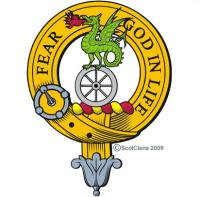
Clan Somerville
This name Somerville derives from a town in Normandy, near Caen. During the Norman invasion of England in 1066, Sir Gaulter de Somerville accompanied the Duke of Normandy, William the Conqueror.
William de Somerville, the second son of Sir Gaulter, came to Scotland with David I and was created Lord of Carnwath, receiving the lands near Carnwath in Clydesdale. He died around 1142 and was buried at Melrose Abbey. Another William de Somerville was said to have killed the last serpent in Scotland, and went on to obtain the lands of Linton from Malcolm IV, in or around 1174. He later became chief falconer to the king and sheriff of Roxburgh. At the Battle of Largs in 1263, a Sir William de Somerville, fifth of that name, fought for Alexander II, driving back the Norse invasion.
The William de Somerville who fought at Largs, his son, Sir Thomas, was amongst the many Scottish nobles who were pressured into signing the Ragman Roll, pledging allegiance to England’s Edward I in 1296. However, in 1297 he joined Sir William Wallace in Scotland’s fight for independence. The peerage of Lord Somerville was created for Sir Thomas, and probably in 1435, though this is uncertain.
The third Lord Somerville, John, successfully fought the English at the Battle of Sark in the October of 1448, where he was wounded. He was also present at the siege of Roxburgh in 1460, where James II was killed. John, the fourth Lord, died in 1523 without issue and his brother, Hugh, succeeded him. He was taken prisoner after the rout at Solway Moss in 1542. He was later released. His son James – later the sixth Lord Somerville – opposed the Reformation and voted against the Scots Confession (a Confession of Faith) proposed in Parliament, which was drawn up by John Knox in 1560. James fought on the side of Mary I at the Battle of Langside, on 13th May, 1568, where he was severely wounded. Hugh Somerville, who became seventh Lord in 1569, also supported Queen Mary, but his allegiance changed and went to her son, James VI. Somerville was then appointed a Privy Councillor by the King. Being in the King’s favour, the Somervilles started living beyond their means, accumulating a big debt, causing them to sell their Carnwath estates. After the 1606 Union of the Crowns, the Scots nobility was ranked, however, the name Somerville did not appear.
By 1723 the Somerville peerage was eventually acknowledged by the House of Lords and John, the thirteenth Lord Somerville, stood for election as a representative peer of Scotland. He built the elegant House of Drum which still stands on the outskirts of Edinburgh. Other noted Somervilles include Mary Fairfax Somerville (1780-1872), from Jedburgh, who was a science writer and mathematician as well as a great pioneer of women’s education. Oxford University’s Somerville College, which was established in 1879, is named after her.








